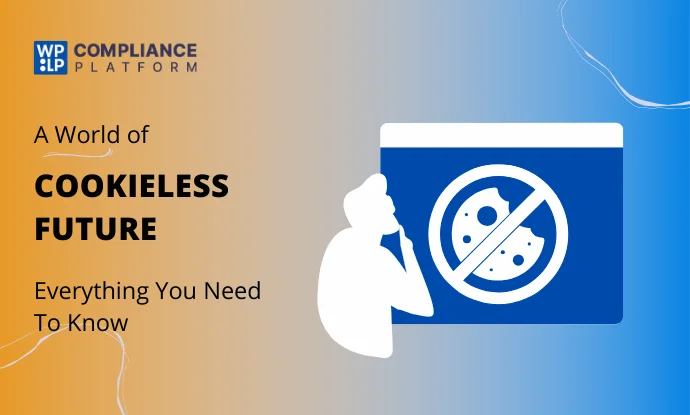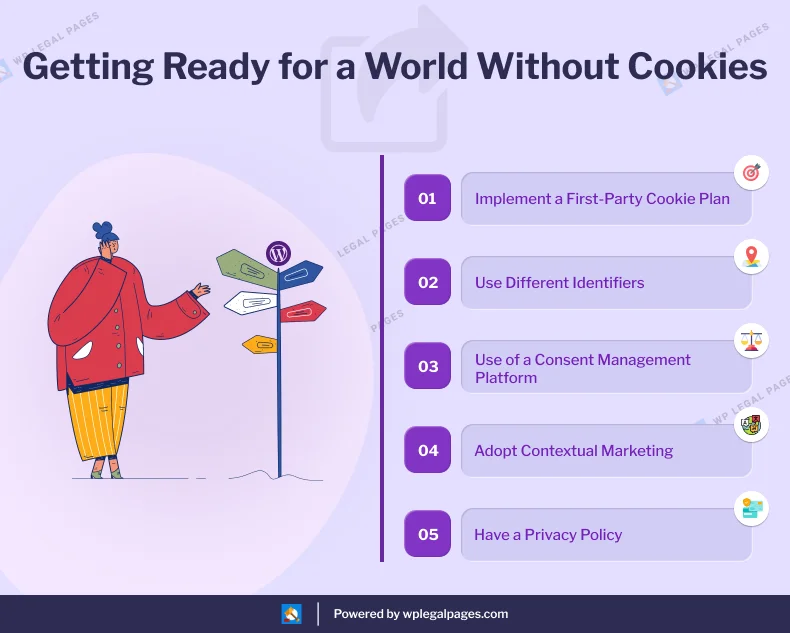Cookieless Future: Everything You’ll Need To Know

Have you ever wondered what a Cookie’s future would look like?
A cookieless future is a digital world without cookies. But is it true that digital cookies are disappearing?
However, with increasing data privacy regulations being passed, rumors about Google’s announcement regarding the phase-out of third-party cookies have made headlines.
In this article, let’s answer all these questions, discuss why these cookies are being phased out, and discuss how you can prepare for this upcoming change.
What Are Cookies?
Cookies are text files placed on your device by websites you visit. They are essential to the world of digital marketing. Cookies allow websites to remember your preferences, monitor your online activity, and store login credentials. Think of them as digital sticky notes.
When websites greet you by name and remember your preferred language, or when e-commerce sites maintain products in your shopping basket while you browse the web, these features improve the user experience.
The two main categories are first-party cookies, which are controlled by the website you visit, and third-party cookies, which are made by external domains and frequently used for targeted advertising.
Third-party data usage has raised serious privacy issues, particularly when tracking user behavior across many websites and gathering sensitive data. As a result, user privacy is becoming increasingly important, and digital advertising is moving toward being cookieless in the future.
Third-party data usage has raised serious privacy issues, particularly when tracking user behavior across many websites and gathering sensitive data.
As a result, user privacy is becoming increasingly important, and digital advertising is moving toward being cookieless in the future.
First Party Cookies
The website (or domain) you visit is directly responsible for storing first-party cookies. These cookies allow website owners to gather analytics information, store language preferences, and perform other helpful tasks that enhance user experience.
When a user logs into an online store like Amazon, a first-party cookie is used. The request is sent via a web browser to maximize user confidence that they communicate directly with Amazon.
This data file is saved to the user’s computer by the web browser under the “amazon.com” domain. A user would have to log in each time they came if first-party cookies were disabled, and they would not be able to make multiple online purchases because the cart would reset after
Third-Party Cookies
Cookies from third-party domains are generated by websites other than the one you are now visiting. These are often inserted on a website using a script or tag and used for online advertising. Any website that loads the third-party server’s code can access a third-party cookie.
Third-party cookies function similarly to the preceding example when a user shops on Amazon. They may spend time on the product pages and look at a few items.
When customers choose to buy only one item, i.e., the brown hat instead of the brown shoes, they may later receive emails and other advertisements for the brown shoes they looked at but never bought.
That tracking data remains active after the user finishes the session and shuts their browser.
How Third-Party Cookies Work?
Third-party cookies embed JavaScript into other websites, allowing them to sync a user’s behavior across websites. Third-party cookies compile information from several browser sessions to create a comprehensive user profile.
For example, visitors browse several categories and scroll through the products they like on a shopping website. If the shopping website were to inject standard cookies, it may remember the items a user has viewed and placed in their cart. Third-party cookies, on the other hand, might share this information with other websites rather than forgetting it.
When you return to the website after setting up third-party cookies, you will see the items you have already viewed and suggested content based on your past choices. Once more, the principal objective of these third-party cookies that record a user’s online activities is to enhance the probability of a conversion.
When users wonder why they are seeing advertisements on websites they are new to, the explanation is typically straightforward: third-party cookies. Third-party cookies are one of the most dependable ways to show users targeted advertisements online.
What Is a Cookieless Future?
When people discuss preparing for a cookieless world, they refer to eliminating third-party cookies.
Third-party cookies are small text files placed on users’ browsers by a third party. For example, if you are part of an advertising network, a script from that network, acting as a third party, may be active on your website.
This script then installs a cookie on your users’ browser, which can be read by other websites within the same advertising network. This allows for targeted advertising. For example, if a user visits a shoe brand, a third-party cookie may ensure that they continue to see advertisements for that shoe brand on other websites.
While this might seem harmless, it’s important to recognize that internet users may be seeking sensitive information such as medical advice or lifestyle recommendations in addition to shopping for shoes.
Therefore, it is essential to inform users about tracking practices and give them control over whether and how they are tracked, even in cases where their browsing activity is innocuous.
This is the main reason for the gradual discontinuation of third-party cookies and marketers’ preparation for a cookieless world.
How To Prepare For Cookieless World
We must proactively adapt to the changing landscape as we approach the cookieless future. Here are some steps for preparing for a cookieless world in this new era of online advertising:

1. Setup a First-Party Cookie Strategy
Third-party cookies are used to give users a more customized experience. Similar outcomes can be achieved while building trust with a first-party cookie approach that is properly implemented.
Concentrate on establishing closer bonds with your audience and gathering information straight from them (of course, with their permission). In a cookieless world, a strong first-party data strategy will position you to offer tailored experiences and targeted advertisements.
Think about implementing customer feedback channels and engagement technologies, establishing connections, and gathering data. This will strengthen your data strategy in a cookieless environment by improving user engagement, trust, and first-party data collection practices.
2. Use Alternative Identifiers
Cookies are an extremely useful tool for user identification and tracking. But when cookies are not used, how can businesses and marketers still do this in the future?
The solution is using tracking signals and alternate identifiers. These are only a handful of the methods that well-run businesses currently employ.
Get acquainted with identity resolution, contextual targeting, and other cutting-edge strategies. By keeping up with the latest advancements and using these new techniques in your marketing plan, you’ll be more ready for the changes.
3. Use Consent Management Platform
If the cookieless future will teach us anything, user privacy is the most important thing.
Getting permission is a crucial step in developing trust and partnerships. With just one line of code, you can establish confidence and guarantee compliance with global privacy rules when you set up a cookie consent management Platform.
CMS platforms such as WP Cookie Consent can help you obtain user consent, making it easier to be transparent about your data and report it through a user-friendly data portal. This tool allows you to clearly communicate with customers about your data collection methods, technologies, and third-party data sharing.
4. Implement Contextual Advertising
Contextual advertising is not dependent on user stories or profiles. Rather, it shows advertising according to the website content the person is now viewing.
You’re connecting with your audience where their interests are. For example, advertising on a mountain trail resembles posting a billboard for hiking gear.
Developing your contextual advertising techniques could be helpful as we approach closer to a future without cookies. Even without cookies, you can use these abilities to use sponsored social media to generate results.
5. Creating a Detailed Privacy Policy
It’s possible that now, more than ever, your users respect their privacy. Make sure your privacy policy is serving their best interests, even if you’ve taken the time to create a compliant one.
Review it once more. If not, you might need to make another change in the future. To create a detailed privacy policy for your website, we recommend you use a WP Legal Pages plugin. This plugin comes with 35+ legal policy templates and helps you create one quickly.
It simplifies creating and maintaining legally compliant documents on your WordPress website. Additionally, it provides several features to safeguard your website and enhance transparency with your audience.
FAQ
A cookieless future means surfing the internet without using any cookies in the coming digital world.
Identity solutions, user identity graphs, digital fingerprinting, and much more will replace cookies in the future.
To prepare for a cookieless future, you need a long-term approach. You must improve first-party data collection, conduct regular incrementality testing, and follow Google’s privacy sandbox guidelines.
Conclusion
As we want to embrace ourselves with the cookieless future, it’s important to remember that the fundamental goal of digital marketing is still reaching the appropriate audience at the right moment.
The cookieless future presents both an opportunity and a challenge. It offers a chance to strengthen and increase the openness of your communications with your clients by prioritizing privacy and, most importantly, preparing for a new digital marketing era where user privacy and trust are critical.
To prepare for a better cookieless future, we recommend using WP Cookie Consent and WP Legal Pages to stay compliant with the law.
If you liked reading this article, don’t forget to read our other engaging articles:
- How To Add Cookie Banner To Your eCommerce Website
- What Is A Cookie Banner And Why Do You Need One For Business
- Consent Management Platform (CMP) – A Guide For Compliance
Are you excited to create a cookie banner for your website? Grab WP Cookie Consent now!
